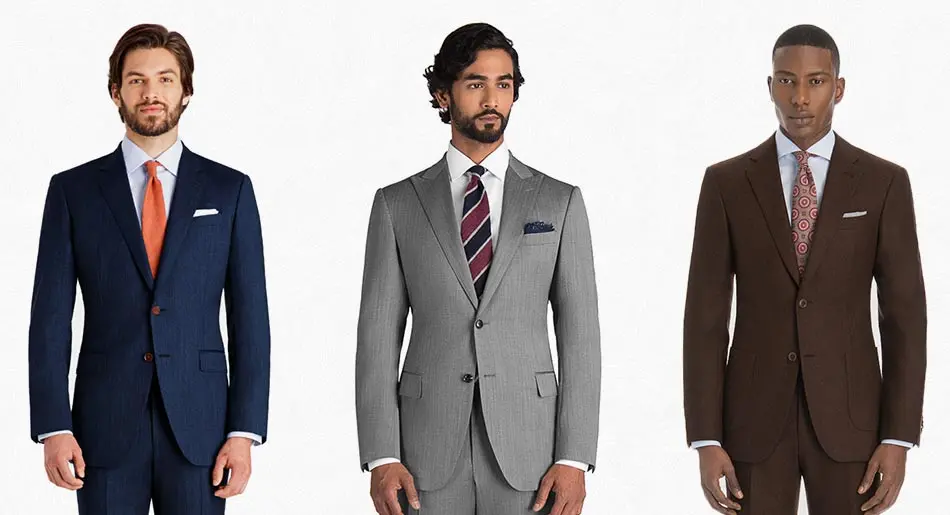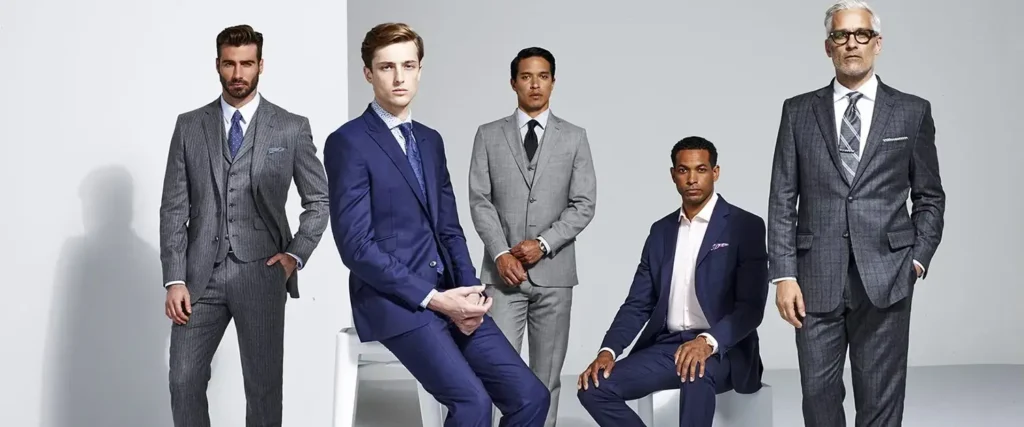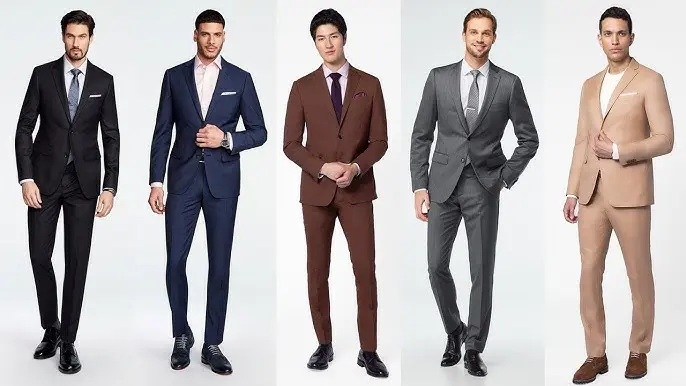A well-fitted suit can make a strong impression, but the color you choose can speak just as loudly as the cut. It can set the tone for your appearance, enhance your natural features, and even reflect your confidence. While most people focus on the style or fit, color is often the element that either pulls everything together or pulls it apart.
Choosing the right suit color isn’t about following trends. It’s about finding a shade that works with your skin, suits the occasion, and aligns with your personal taste. The wrong color can make a suit feel flat or out of place, but the right one can elevate your entire look.
In this guide, we’ll walk you through six thoughtful things to consider before settling on a suit color. Whether you’re preparing for a wedding, refreshing your work wardrobe, or simply adding a new piece to your collection, these tips will help you choose a suit that not only looks great but also feels right.
Consider Your Skin Tone and Undertones
The first, and perhaps most important, step in choosing the right suit color is understanding your skin tone and undertones. This isn’t just a grooming tip; it’s a game-changer for how your suit complements your overall look.
Start by identifying your undertone. If your skin has hints of blue or pink beneath the surface, you likely have cool undertones. If you notice golden or peachy hues, your undertones are warm. Neutral undertones fall somewhere in between. This subtle detail can guide you toward colors that enhance your complexion instead of competing with it.
For example, men with cool undertones tend to look great in navy, charcoal, and slate gray colors that echo their skin’s natural coolness. Those with warm undertones can glow in shades like camel, olive, and rust. These tones create harmony with their warmer complexion without overpowering it.
Understanding skin tone color isn’t about boxing yourself into a rule; it’s about choosing colors that help your features stand out naturally. When your suit matches your tone, everything from your eyes to your smile becomes more noticeable. It’s a quiet confidence that shows before you say a word.

Occasion Matters: Match the Mood
Every suit tells a story, and that story should align with where you’re going and who you’ll be with. Choosing a suit color without considering the occasion can lead to mismatched energy. A light tan at a corporate interview may feel too relaxed, while a deep black ensemble at a daytime beach wedding might come off too formal or heavy.
Formal events such as weddings, award ceremonies, or gala dinners often call for deep, elegant tones like navy, midnight blue, or classic black. If you’re the groom or a groomsman, your color choice can also tie into the wedding palette. The best suit color for men in wedding settings often includes versatile hues like grey, deep blue, or even soft ivory—depending on the time and theme.
For business settings, stick to timeless colors that speak of professionalism and polish. Think navy, dark grey, or subtle pinstripes. Here, the cut and structure matter just as much as the color—well-executed suit tailoring paired with a balanced shade communicates reliability and focus.
On the other hand, social gatherings or creative events allow more room for personal expression. This could be your chance to explore lighter tones, richer textures, or bolder colors that wouldn’t fit a formal boardroom.
Ultimately, the right color supports the setting. It shows you understand the tone of the event and know how to present yourself thoughtfully and with intention.

Go Beyond Black: Explore Timeless Neutrals
When people think of formalwear, black often comes to mind first, but the world of suits gets far more interesting (and practical) once you explore neutrals. These shades work across seasons, mix easily with shirts and ties, and flatter a wide range of complexions and personal styles.
Charcoal for Dependable Polish
A charcoal grey suit is one of the most versatile pieces you can own. Deep enough for formal settings yet softer than stark black, it transitions from office meetings to evening events with ease.
Classic Black, Used Wisely
There’s still room in the wardrobe for a mens suit black, especially for high-formality moments, evening functions, or minimalist dressers. Just know it can feel severe in bright daylight, so reserve it for when the setting supports its drama.
Light and Mid Greys for Range
If you want a fresher, modern alternative, look to light grey suits for spring, summer, or daytime ceremonies. A tailored mens gray suit in a mid-tone gives you year-round flexibility and pairs well with both subtle and bold accessories.
Neutrals That Work for Everyone
These foundational shades also make choosing a suit color for women easier, since charcoal, black, and varied greys provide clean canvases for styling with blouses, scarves, or jewelry.
Neutrals are the backbone of a confident wardrobe: versatile, repeatable, and endlessly styleable.

Think About Your Natural Contrast
Have you ever seen someone in a suit and thought, “That just works”? Chances are, the color of their suit was perfectly in sync with their natural contrast—the relationship between their hair, skin, and eye color. It’s a subtle styling trick that can make a big visual difference.
If you have high contrast — say, dark hair with light skin, or bright eyes with deeper skin, bold suit colors will enhance that natural distinction. Deep navy, strong blue, or rich burgundy can sharpen your look and help you stand out in a polished way. For example, the best suit color for white skin male with dark hair might be navy or medium grey, which plays nicely with the skin tone without washing it out.
On the other hand, if your contrast is lower, like brown hair with brown eyes and medium skin, muted or blended tones will look more natural. Think earthy colors, soft greys, or subtle patterns. The best suit color for brown skin male, for instance, might include hues like olive, sand, or deep chocolate tones that bring out warmth without being overpowering.
This also applies to accessories. High-contrast individuals can pull off striking shirt and tie combos, while those with lower contrast might look better with tonal layering.
Understanding contrast isn’t about hard rules; it’s about harmony. When your suit color supports the natural balance in your appearance, the result feels effortless and excellent.

Consider the Season and Time of Day
The time of year and the hour of your event both play a big role in choosing the right suit color. Just like you wouldn’t wear heavy wool in the middle of summer, certain colors feel out of place when the season—or setting—doesn’t support them.
Spring and Summer
Warmer months invite lighter, breezier hues. A tan suit is a perfect example—fresh, comfortable, and seasonally appropriate. Other warm-weather favorites include stone, cream, and pastel tones like the increasingly popular sage green suit. These colors reflect sunlight beautifully and give off a relaxed, stylish energy.
Autumn and Winter
When the temperature drops, darker colors come into their own. Think deep navy, burgundy, olive, and chocolate brown. Heavier fabrics and richer tones naturally suit the mood of colder seasons. For fall weddings or formal evenings, they strike the perfect balance between elegance and warmth.
Day vs. Evening
The time of day also matters. Lighter shades work better for daytime events, offering a softer, more approachable look. Evening affairs, on the other hand, allow for more drama, making room for bolder choices like black, midnight blue, or even jewel tones. A white suit ensemble can also work beautifully for upscale evening events, especially when paired with minimal accessories and sharp tailoring.
Choosing your suit color with the season and time in mind ensures you look well-prepared, intentional, and in sync with your surroundings.

Explore Stylish Color Combinations and Trends
Once you’ve nailed down the main suit color, it’s time to think about how everything else fits together. From shirt and tie pairings to accessories and seasonal flair, knowing how to build a cohesive look takes your style to the next level.
Shirt and Tie Harmony
The easiest way to create a polished look is to stick with contrast and coordination. A pale blue shirt with a navy suit, for example, is timeless. A crisp white shirt with a men brown suit feels warm and grounded. Add a tie that either complements or tastefully contrasts, and you’ve got a balanced outfit that feels considered—never clashing.
Try Warmer Tones
While cool colors like navy and grey remain staples, warmer colors like burgundy, camel, and copper are finding their way into everyday menswear. They bring personality without shouting, and when paired with neutral shirts and shoes, they strike a confident tone.
Mix Textures and Shades
Sometimes it’s not about bold colors, but how you layer them. Mixing textures (like wool with silk or linen) adds depth. Try pairing a solid brown suits for men option with a patterned tie, or layering a subtle print shirt under a light grey blazer. Little contrasts create visual interest without being loud.
Consider the Occasion’s Palette
Weddings and themed events often call for coordinated looks. Pay attention to colors being worn by the bridal party or other guests. The suit colors for wedding celebrations may range from soft pastels to deep jewel tones, depending on the setting and season.
Use Style Tools
If you’re ever unsure, a suit color combinations chart can help you visualize how your chosen colors play together. Think of it as your roadmap for a look that’s stylish, well-coordinated, and uniquely yours.
Add a Twist with Trends
Current favorites like the white suits for men, sage green, and dusty rose offer a modern, fashion-forward alternative to traditional picks. Even black suiting has seen a refresh, slimmer cuts, matte fabrics, and minimal styling keep it current without losing its formal appeal.
When you’re willing to explore, suit color becomes more than a choice; it becomes an expression.

Conclusion
Choosing the right suit color isn’t just about looking good; it’s about feeling like the best version of yourself. The shade you wear should complement your skin, match the mood of the event, and express your personality with confidence. From timeless neutrals to trend-forward hues, the possibilities are endless when you understand the subtle art of color coordination.
By considering your skin tone, the occasion, seasonal influences, natural contrast, and the latest styling trends, you’ll be able to select suit colors that are not only flattering but also uniquely you. Whether it’s a tan suit for a summer wedding or mens gray suit for the office, every color tells a story. The key is choosing the one that tells yours best.
When in doubt, start simple, then let your confidence grow with every new piece you try. Because the most important thing you can wear is assurance in your own style.

